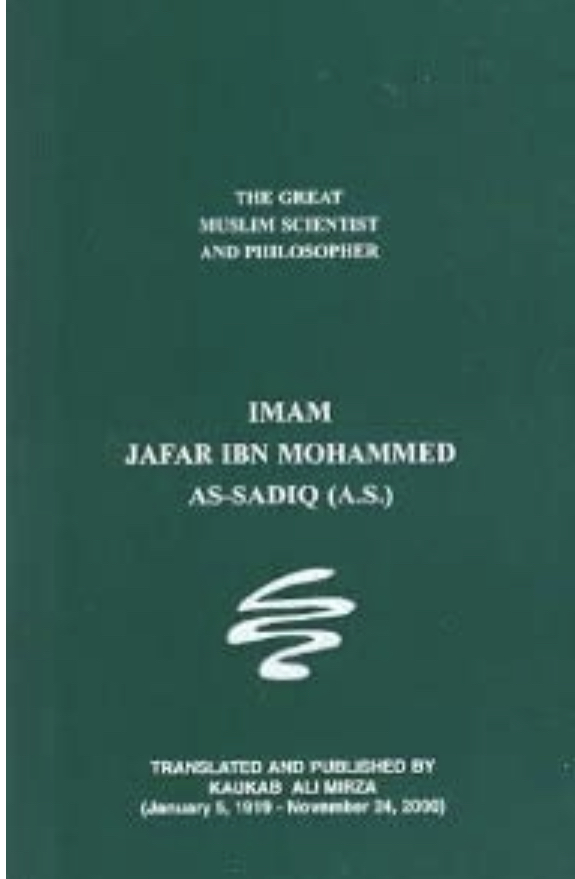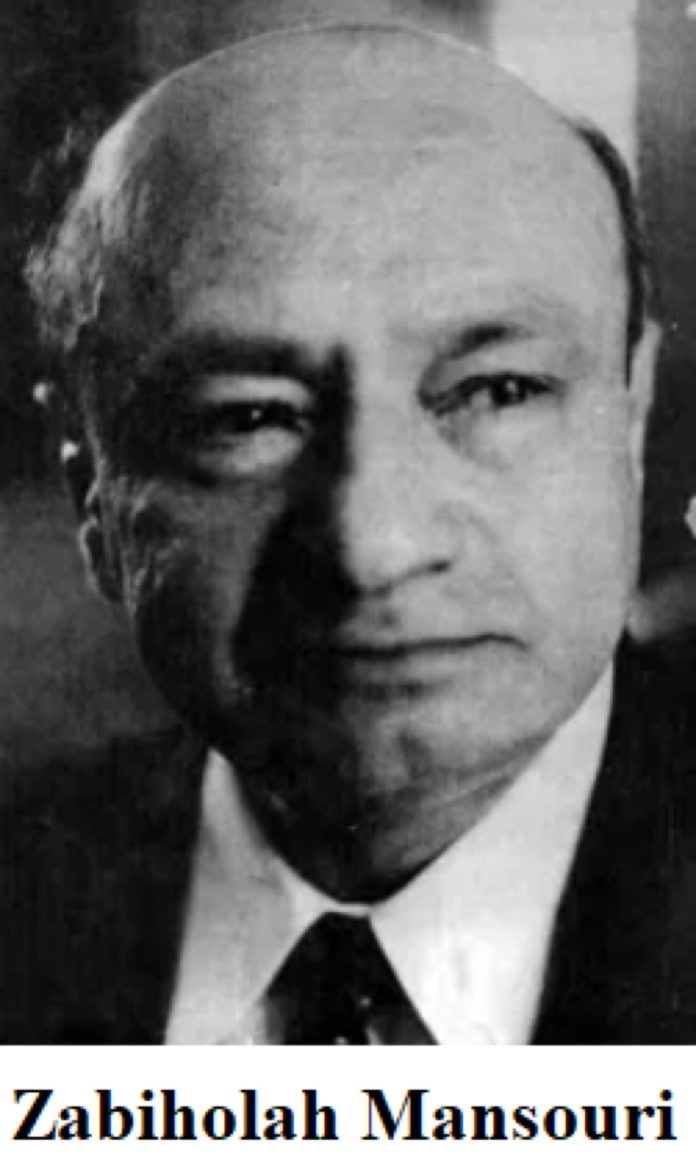(The article was first published in Mukaalma by Hamza Ibrahim.)
Translation: Rabia Aslam
A book titled “superman in Islam” in Urdu was first published by Qiyam Publications Lahore in 1994, the subject of which was the scholarly work of Imam Jafar Sadiq. The cover of the book states that it was written by 25 Western Orientalists.

This book is an Urdu translation of a Persian work of fiction titled “maghze mutafakkir jehane shi’a (مغز متفکر جهان شیعه) ” and its author’s name is Zabiholah Mansouri (died 1986). The original book was first published in Iran in 1975. Its translation into Arabic was published in Beirut under the title “al-Imam al-Sadiq – kama arafahu ulema al-gharb(الإمام الصادق كما عرفہ علماء الغرب)”. Kaukab Ali Mirza, a Pakistani living in Canada, translated the book into English in 1996 and published it under the title “The Great Muslim Scientist and Philosopher – Imam Jafar Ibn Muhammad Al-Sadiq.” Qiyam Publications Lahore has also published this English translation in Pakistan.
All these manuscripts have been published many times while the publishers have made some handsome profits. The Persian book has also been included by the iranian sufi Ayatollah Syed Mohammad Hussain Tehrani in the eighteenth volume of his book “Imam Shinasi”. The Urdu translation of this book is one of the most widely read books among the Pakistani Shia community. The book had such an impact on some Shia scholars in Iran and Iraq that they spent years searching for scientific miracles in the Qur’an and Hadith that were mentioned in the manuscript. As, just like Zabiholah Mansouri, they were not much acquainted with science, they promoted many pseudo-scientific ideas in their books, some of which have been translated into Urdu as well.
Zabiholah Mansouri was born in 1899 in Sanandaj, Iran. He received his early education at the Alliance School, which was run by French men working in Iran. From there, he learned French. His father was later transferred to Tehran and he moved there with him. In his early youth he lost his father and the burden of supporting the family fell on his shoulders, due to which he could not acquire higher education. In 1922, he started working as a translator in various newspapers and magazines. He died in Tehran in 1986.
His only source of livelihood was translating as well as writing popular-opinionative books. Naseem Hijazi and other writers of historical fiction are prime examples of this in Pakistan. Such people were not mature in terms of knowledge and their financial needs demanded that such books be written which captivate the masses in religious fervor. People would read and distribute their books in quest of earning heavenly rewards. Whether it is Oriya Maqbool Jan, Ansar Abbasi, Javed Choudhari in Pakistan or Hassan Abbasi, Hussain Shariat Madari or Hassan Rahimpur Azghadi, etc. in Iran, such characters make up a modern batch of semi-literate but religious fiction writers of the cold war era. To portray that Islam is in danger and then selling solutions to this problem are the means of earning their living.
Unfortunately, such people are also filling the place of Goebbels for semi-literate leaders of some Muslim countries.
The publisher uses the same rhetoric when he writes in the preface that:
“The importance of the issue of wars of civilizations in modern times has brought the Islamic world to a critical but sensitive juncture. . . The book under review is an important part of our fight against this attack on Islam. This book is so unique in its subject matter that no such effort has come to light in Urdu language before. The original text of the book is in French. It has been compiled by a group of twenty-five intellectuals. ”
The following pages, under the heading “Persian Translator’s Foreword”, also list the names of the supposed scholars who participated in a research program at the Center for Islamic Studies in Strasbourg, France, and compiled the book. There are two Muslim names, of which Mr. Musa Sadr is actually the Lebanese Shiite scholar Ayatollah Musa al-Sadr and the other Mr. Hussein Nasr is actually the well-known author Dr. Hussein Nasr. These two gentlemen never owned this book. The other 23 names are Zabiholah Mansouri’s own invention and these “scientists” have no connection with these universities, most of which do not even exist. No such book has been written in French or any other European language. No copy of the alleged French book is available in any library either. There has never been an Islamic research center in the French city of Strasbourg. Oozing ignorance can be found in the book and sadly it has been attributed to Imam Sadiq with no references being provided.
The fact is that if any research on the scientific achievements of Imam Jafar Sadiq was possible, it would have taken only one year for a university professor to do research on the subject. There is no need to spend millions of dollars on a team of 25 scientists. The truth is that no one has ever written on this subject except few journalists.
As far as the content of the book is concerned, most of it is fabricated and made-up. The book states that Imam Sadiq (d. 765) taught Ptolemy’s astronomy and geography as well as Euclid’s geometry and Greek philosophy. The author did not consider it appropriate to provide any reference to this claim. Since these books were not translated into Arabic in the time of Imam Sadiq, Mansouri claims that Imam learned these sciences from his father Imam Muhammad Baqir. However, Mansouri did not know that the Greek sciences were very primitive and the work of the Greek scholars is respected only because they raised meaningful questions and made a tradition of finding answers to them in the age of ignorance, not that their answers were correct.
Translation of Greek works into Arabic had begun in the Umayyad period because they were needed to make steel, to measure the density of gold and silver for currency, to make maps, to calculate the treasury, and to manufacture weapons. The Abbasid Caliph Mamun accelerated this work by establishing a institution called “house of translations” and sent delegations to the Roman Empire to order Greek books. In the following centuries, when Muslim scientists worked on them further, they did not mention Imam Sadiq but attributed these sciences to the Greeks. The famous Shiite scholar Khawaja Naseer-ud-Din Tusi (d. 1274) also based his scientific work on Ptolemy in his book “al-tadhkira fi ‘ilm aI-hay’a (Memento in astronomy)”.
According to Mansouri, Ptolemy (d. 170 AD) had proposed the idea of the earth being round in his book “almagest”, while Archimedes (d. 212 BC) and Aristarchus (d. 230 BC) had already stated this concept. The Almagest is a 2nd-century Greek-language mathematical and astronomical treatise on the apparent motions of the stars and planetary paths, written by Claudius Ptolemy. It was a common observation of the Greeks that when ships left Egypt for Greece, they sank and disappeared, and on their way back they suddenly appeared from the horizon with their top appearing first on the scene, which was evidence of the surface of the sea being round. This was proved by measuring different angles of the shadow of the same stick at different places in Egypt at the same time, and with this experiment Greek scientists also measured the diameter of the earth. According to Mansuri, Imam Sadiq told this concept to the Arabs before the translation of almagest. He did not present any narration in support of his claim. However, the narration by Imam Sadiq about the earth in Usul Kafi states:
“Abban ibn Tughlab asked Imam Sadiq, on what is the earth laid. The Imam said, on the fish. He asked, and what does the fish rests on? Imam said on the water. He asked on what is the water laid, Imam said on a rock. He asked on what is the rock laid, the Imam said on the horn of a cow. He asked where does the cow stands, Imam said in the mud. He asked on what is the mud laid, Imam said alas! the intellect of the scholars cannot comprehend what lies beyond this. ”(Muhammad ibn Yaqub Kulayni, Al-Kafi, vol. 15, p. 221, Dar al-Hadith, Qom, first edition, 1429 AH).
There are many claims in the book which has nothing to do with the theories expressed in the Almagest. In addition, many things are also wrong in the Almagest and in attributing the Almagest to the Imams of the religion, there is a danger of attributing these mistakes to their thoughts and opinions which Mansouri could not realize due to his shallow ignorance.
An example of this is the theory of seven heavens. In the time of Ptolemy, telescopes were not invented to look at the sky, and Galileo (d. 1642) was the first to use telescopes to look at the sky. The concept of five visible planets rising every night from a different place was a mystery for observers. Ptolemy assumed seven heavens for the five planets, sun and the moon and said that these seven skies are like invisible spheres around the earth centered at earth. The rest of the stars, which rise at the same place every night, some of whom were named after, were first thought to be nothing more than small lamps set up to adorn and beautify the sky and help sailors at the sea. Now science has proved these things wrong. We now know that the earth is not different to sky but part of it. The earth is so small compared to the sky as if it was a tiny grain in the desert of stars. The stars are very far away and they are seen rising from the east every night and floating slowly towards the west because the earth is in spinning.
Now we can understand that if anyone had said these things in those days, he would have been called insane and heretic. He may have been declared an apostate and beheaded. Due to these political compulsions, no religious leader has ever been able to speak beyond the mental level of his addressee, and religious books teach us not to clash with the science of our time, as in the above narration Imam Jaffer Sadiq responded according to the Arab wisdom of his environment.
Mansouri later associates the discovery of Oxygen to Imam Sadiq. He also called Imam Sadiq a person who disproved the concept of the four elements, while this concept has been common among all Muslim scientists of the Abbasid era. Mansouri calls Imam Sadiq the founder of Sufism. This is an open contradiction to him being scientist. The historical fact is that the decline of science among Muslims was due to the spread of Sufism. This deviation first came to the Ahl as-Sunnah as a result of Imam al-Ghazali’s (d. 1111) Tahafat al-Falasfa, and later Mullah Sadra (d. 1635) uprooted the remnants of science among the Shiites. These two gentlemen pushed the Muslim man-power interested in rational sciences into the abyss of pseudo-science and turned them away from physical sciences, and in the 16th century CE, the dark age of Islamic world finally began.
Later in the book, Jabir Ibn Hayyan (d. 803) is said to be the founder of modern chemistry, while the fact is that Jabir did not discover any law of chemistry. Jaber based his work on the Greek science of metallurgy available in his day. He made crude nitric acid from animal dung, which was used to remove rust from metal surfaces. Undoubtedly, this work is a great achievement of that period, but by attributing it to Imam Sadiq, the mistakes of Jabir will also be attributed to him.
Here it is necessary to pay attention to another point: as the time passes, scientists of new age are always superior in knowledge than old ones. For example, nowadays a matriculation child knows chemistry much better than Jaber bin Hayyan or Physics much better than Ptolemy. But in the matter of religion, the position of the old scholars is always higher than that of those who came after them. For example, no Hadith scholar of today can know Hadith better than Imam Bukhari or Sheikh Kulayni. Those who try to create a link between religion and science are insulting religious elders and books. Religion and science can never intermix, and we need both in their right place.








